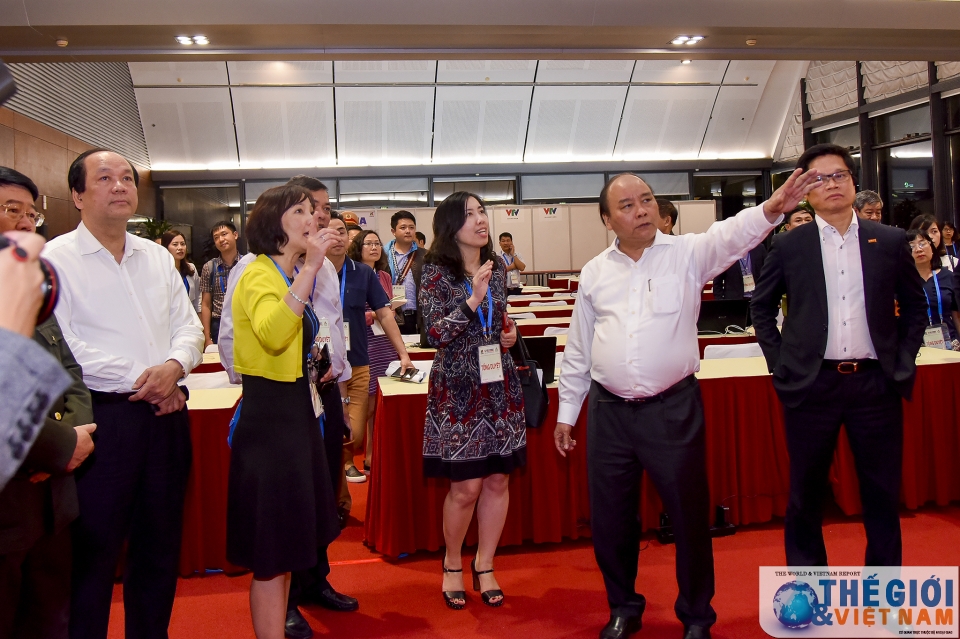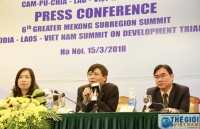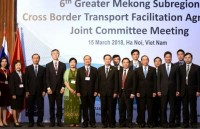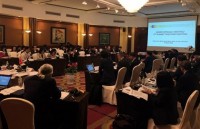
Mekong - The river of cooperation and development
Latest
| TIN LIÊN QUAN | |
| PM Nguyen Xuan Phuc chairs rehearsal for GMS-6, CLV-10 | |
| PM requests best preparations for GMS-6, CLV-10 | |
The World and Vietnam Report introduces the full text of the Prime Minister Nguyen Xuan Phuc's writing:
"With the Prime Minister’s leadership, Viet Nam raised the initiative of holding for the first time the GMS Business Summit forum. This initiative has received the consensus from all GMS members and the support from key partners: the Asian Development Bank (ADB), the World Bank (WB) and ASEAN, to name a few. The wide support of the business community is particularly heartening, with more than 2,000 businesspeople both Vietnamese and international registering (on par with the APEC Business Summit in 2017). This is an expression of the enthusiastic spirit of entrepreneurship and the faith of the business community and investors in the open-door reform policies of the Governments and the excellent business opportunities opening up in the GMS and CLV regions, rich in development potential, in the context of an Asia arising as a driver for global growth in the 21st century.
Mekong cooperation – promoting regional connectivity
The Mekong subregion consists of five countries bound by the Mekong: Viet Nam, Cambodia, Laos, Myanmar and Thailand. From the early 1990s, against the backdrop of regionalization and given the need for greater economic integration, cooperation in the Mekong has seen a major shift. If early on, Mekong cooperation only focused on within the riparian countries, at present it has expanded to include many more cooperation mechanisms between the Mekong countries and major partners, including the United States, China, Japan, India and the Republic of Korea. The interest of the international community and development partners stem from the strategic location as well as the strong potential for growth of this region.
The GMS Economic Cooperation Program, assisted by the ADB is the first mechanism to be formed in the region in 1992, comprised of the five Mekong countries and China (represented by the two provinces of Yunnan and Guangxi), with the goal of promoting and facilitating mutually beneficial economic cooperation between the countries, making the Mekong region a fast-growing and prosperous region in Southeast Asia.
 |
| (Photo: Nguyễn Hồng) |
A number of other cooperation mechanisms have also been formed: CLV DTA Cooperation, Cambodia – Laos – Myanmar – Viet Nam (CLMV) Cooperation and the Ayeyarwadi – Chao Phraya – Mekong Economic Cooperation Strategy (ACMECS) between Thailand, Myanmar, Cambodia, Laos and Viet Nam. These mechanisms aim to narrow the development gap and assist the Mekong countries in integrating further into the regional economy and promoting cooperation in addressing common challenges. Among these, CLV cooperation was formed in 1999 and seeks to promote solidarity and cooperation, ensuring security and political stability, and reducing poverty and promote socio-economic development in the three countries Cambodia, Laos and Viet Nam.
Mekong cooperation mechanisms has had very important contributions to the development of the region. These cooperation frameworks, in essence mechanisms for policy coordination, are forums for the Mekong countries to strengthen confidence and promote dialogue in order to address common challenges on the basis of harmonizing interests among the parties – challenges that are impossible to overcome with the individual effort of each country or even with bilateral cooperation. In addition, Mekong cooperation mechanisms, through concrete programs and projects, have also made substantial contributions to regional connectivity, narrowing the development gap and raising the people’s living standard.
In this process, development partners have played a major role. Within the framework of GMS cooperation, the countries and development partners have raised some $21 billion for economic and social development projects in the six member countries. Japan assisted Mekong countries with around ¥1.1 trillion ($13 billion) for the 2009 – 2015 period, and has disbursed two thirds of the JP¥ 750 billion ($6.5 billion) pledge for the 2016 – 2018 period. The United States donated $50 million to the Lower Mekong Initiative (LMI) and pledges $1.25 million to initiate the Sustainable Infrastructure Project for the 2016 – 2018 period. India is making a $1 million annual contribution for the India-CLMV Quick Impact Project (QIP) Revolving Fund, and continues to give scholarships to Mekong countries. The RoK pledges to make a $1 million annual contribution to the Mekong – RoK Cooperation Fund. Just recently, China has made a plan to invest some $10 billion for the region, in particular in North-South transport connectivity. China also pledges $300 million to the Mekong – Lancang Special Cooperation Fund, along with many preferential loans and buy-side credit lines.
As a whole, the Mekong region is Viet Nam’s immediate security and development space. In addition to contributing to creating a peaceful and enabling environment in the region, thus helping Viet Nam’s stability and development, Mekong cooperation implementing in Viet Nam is also bringing about concrete benefits.
First, Mekong cooperation mechanisms is an important channel for Viet Nam to mobilize resources from development partners for domestic economic and social development, boosting growth and regional connectivity and reducing poverty, in particular in the border regions. By December 2017, connectivity projects within the GMS framework alone account for $6 billion (30% of the total mobilized funds of GMS)
Such familiar names as the Ho Chi Minh City – Moc Bai route, the upgrade of Da Nang Port, the second international Mekong bridge connecting the land routes from Thailand – Laos – Viet Nam to the East Sea, the Kunming – Hai Phong Corridor, the Noi Bai – Lao Cai motorway, being the longest expressway in Viet Nam, and many other programs and projects within the Mekong cooperation framework are bringing about very concrete benefits for the Vietnamese people.
Second, Mekong cooperation promotes economic connectivity between Viet Nam and other countries in the region. Many important cooperation agreements and joint development plans have been signed, thus contributing to further trade and investment ties among the member countries. Cultural and social cooperation programs have also helped to promote people-to-people exchanges, strengthening mutual understanding, affection and bond among the people along the river.
Third, participation in Mekong cooperation frameworks helps establish additional dialogue channels with countries in the Mekong river basin and attracts the attention and sponsorship in both financial and technical terms from development partners for the sustainable management and use of the Mekong water resource. In addition to the Mekong River Commission (MRC), Viet Nam is also working with the other countries in protecting the environment and water security in other Mekong cooperation mechanisms.
Viet Nam – an active member
Being deeply aware of the importance of the Mekong region, Viet Nam has been actively taking part in all Mekong cooperation mechanisms, joining hands with other members in building an effective working mechanism that would build on the strengths of all parties and meet the development needs of the region. A number of Viet Nam’s remarkable contributions are worth mentioning:
First, in trade and investment, Viet Nam has participated in trade and investment facilitation activities within the GMS framework, including the Strategic Framework for Action on Trade Facilitation and Investment (SFA-TFI), which is primarily about customs procedures simplification, sanitary and phytosanitary regulations harmonization to reduce inspection time at border checkpoints, logistics capacity improvement, and visa procedure simplification for businesspeople in the region.
Apart from cooperation in developing hard infrastructure, Viet Nam and GMS countries have completed the signing of all protocols and annexes of the GMS Cross-Border Transport Facilitation Agreement (CBTA-GMS); and at the same time signed a memorandum of understanding on the ‘early harvest’ implementation of the CBTA-GMS. The “one-stop-shop” model of inspection has been implemented at the Lao Bao – Densavan border checkpoints between Viet Nam and Laos starting from 2015. Presently Viet Nam is also negotiating for the pilot implementation of this model at the Moc Bai – Bavet border checkpoint between Viet Nam and Cambodia.
 |
| PM Nguyen Xuan Phuc chaired the rehearsal for GMS-6, CLV-10, March 27. (Photo: Nguyen Hong) |
Second, in environment and water resource management cooperation within Mekong frameworks, Viet Nam has, together with MRC members, actively negotiated for and finalizing regulations and procedures for data sharing and monitoring the current water usage, undertake prior informing and discussion on the use of water, and maintain the flow along the main stream of the Mekong to translate into reality the Mekong Agreement and the responsibility of member countries in protecting the Mekong water resource.
Within ACMECS, Viet Nam is the first country to raise the idea of establishing an environment working group, draft an Action Plan and co-chair the working group. Viet Nam also plays the leading role in environmental cooperation in Lower Mekong – US Cooperation; and actively shares in the “A Decade Towards a Green Mekong” initiative in Mekong – Japan cooperation. Viet Nam also actively partakes in water resource cooperation in the Mekong – Lancang mechanism. Within GMS, Viet Nam enthusiastically takes part in building the GMS Strategic Environment Protection Framework, establishing an environment data and management system, reducing poverty and managing the environment in remote areas and upstream woodlands, managing and protecting the mangrove swampland in the lower Mekong, and strengthening institutions and traiing for environment protection..
Third, in education and training, Viet Nam has dispatched hundreds of officials on scholarship and training programs within sub-regional cooperation mechanisms across many areas, including infrastructural network management, project design and assessment, trade and education management policy-making and leadership in development to name a few. Viet Nam also participates in the building of the Strategic Framework and Action Plan for Human Resource Development in the GMS for the 2009 – 2012 and 2013–2017 periods, which aims at promoting sustainable human resource development, assist the implementation of regional human resource cooperation initiatives, and addressing trans-border issues pertaining to human resource among the GMS countries.
In addition, Viet Nam has been receiving many officials and students from Laos and Cambodia attending the Tay Nguyen University, and is granting assistance to the building of boarding schools in the provinces of Sekong (Laos) and Ratanakiri (Cambodia). Within CLMV, Viet Nam established a CLMV scholarship in order to provide hundreds of scholarships per year for Cambodia, Laos and Myanmar. This is one of the 58 pilot projects to be implemented, and one of the most outstanding results of CLMV cooperation.
Fourth, far from merely benefiting, Viet Nam has also made significant contributions to GMS cooperation in many forms such as organizing conferences and seminars, drafting important documents, promoting initiatives and financial assistances. Viet Nam successfully hosted the 7th ACMECS and 8th CLMV Summits (In October 2016), the second Mekong – Japan Summit, the third Mekong – Japan Ministerial Meetingand the second Mekong – US Ministerial Meeting (2010), and, in particular, the GMS-6 and CLV-10 Summits in Hanoi from 29 to 31 March 2018.
In CLV DTA cooperation, Viet Nam has worked closely with the other countries in reviewing and redrafting the DTA Planning until 2020, and establishing the DTA’s official site in four languages (Vietnamese, English, Laotian and Khmer). We have assisted Laos and Cambodia in building a number of key link roads that connect border provinces, and establishing border markets and joint patrol stations. Vietnamese businesses have invested into more than 100 projects in Laos and Cambodia’s DTA provinces with a total registered capital exceeding $3.8 tbillion, with the slogan of combining Vietnamese capital, technology and market with Laotian and Cambodian labor and land potential
Mekong cooperation mechanisms are very significant to and in line with Viet Nam’s economic and social development priorities. Given her raised status and power as well as the development and international integration experience gleaned across the last 30 years, Viet Nam is now better able and poised to participate in Mekong cooperation, thereby serving the nation’s economic and social development and contributing to peace, cooperation and development in the region."
Prime Minister Nguyen Xuan Phuc
 | Business Forum a highlight of GMS-6 The first-ever GMS Business Forum will be a highlight of the sixth Greater Mekong Sub-region Summit (GMS-6) to be held in Vietnam later this month, ... |
 | Facilitation of cross-border transport throughout the GMS reviewed The sixth Joint Committee Meeting of the Greater Mekong Subregion Cross-Border Transport Agreement (GMS CBTA) was held in Ha Noi, on March 15, to review ... |
 | Senior officials discuss preparations for 6th GMS Summit Senior officials of the Greater Mekong Sub-region (GMS), including Cambodia, Laos, Myanmar, Thailand, China and Vietnam, and representatives from the Asia Development Bank gathered in ... |

















